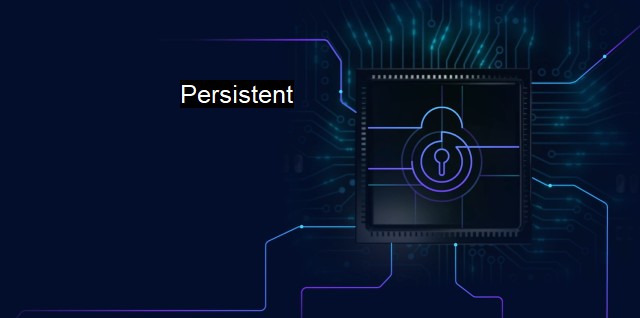What is Persistent?
The Critical Importance of Persistence in Cybersecurity: Understanding Malware Strategies and Detection Measures
Persistence in the context of cybersecurity and antivirus refers to a particular behavior or property of some forms of malware that enable them to maintain their existence and continue running on a compromised device even after a restart or shutdown. These malicious software, often referred to as 'persistent threats,' are designed to elude detection and maintain a lingering presence, granting hackers persistent access to compromised networks or devices for prolonged periods, facilitating extended periods for data theft or other malicious activities.Understanding the persistence techniques used by this malware can be crucial in the endeavor to detect, neutralize, and remove these threats. Most commonly, these techniques involve the malware writing itself into a place that automatically runs code when the operating system boots up, such as in autostart entries, the windows registry, or scheduled tasks. Some write themselves into the firmware, which is equipment control software stored on the hardware itself, causing the malware to load even before the operating system starts. This typically makes firmware rootkits effectively invisible to antivirus software and exceedingly difficult to remove.
Expanding further, another popular technique for persistence involves a rewrite of the master boot record (MBR), the part of the computer’s hard drive that initiates the boot process. When the MBR is rewritten, the malicious code becomes essentially the first thing launched when a computer is turned on, before the operating system and antivirus programs. Others use a method called process injection, where the malware inserts itself into a running method carried out by the operating system or even a trusted application that would fly under the radar of most antivirus scans.
Malware which is not persistence works comparatively simple. Once these have infected a machine, they run and perform their damaging activities. Still, these activities do not continue after turning off the machine. Therefore, rebooting the machine can end their execution. That said, this does not imply that non-persistent malware is less dangerous–they can still inflict considerable harm. A quick restart may dell them, but any damage already done remains, and the vulnerability that let them in likely remains as well.
In contrast, persistent malware digs deep into the infected system and plants its roots solidly, all while attempting to stay under the radar. Persistent malware can also have polymorphic capabilities, meaning it can change its code to avoid the signature-based detection used by many antivirus solutions. Consequently, even if detected and seemingly removed, it might persist, lying dormant and then staging a resurgence when the coast is seemingly clear.
Preventing persistent threats requires a multi-layered approach to cybersecurity. Traditional antivirus that operates on signature is inadequate on its own. Advanced security solutions that implement detection technologies such as heuristics and behavior-based identification are required. a comprehensive defense approach should include intrusion detection and prevention, vulnerability scanning and remediation activities, continuous network monitoring, and education of users about malware threats.
Persistent is a characteristic of highly advanced or sophisticated malware, enabling them to stay in the affected system for an extended period without detection. The tenacity of these attacks, coupled with their ability to avoid detection and survive various eradication attempts, highlight the necessity for comprehensive and continuous defensive strategies at all levels.

Persistent FAQs
What does "persistent" mean in the context of cybersecurity and antivirus software?
In the context of cybersecurity and antivirus software, "persistent" refers to malicious software that can continuously stay active and undetected on a system. Persistent threats can include advanced malware, rootkits, and botnets that can evade traditional security measures and remain present on a system for an extended period of time.Why are persistent threats a major concern for cybersecurity professionals?
Persistent threats can remain undetected for an extended period of time and can cause significant damage to a system if left unchecked. They can steal sensitive data, disrupt critical services, and allow unauthorized access to a network. Additionally, persistent threats often use sophisticated tactics to evade detection and can be challenging to detect and remove.What are some strategies that cybersecurity professionals can use to detect and mitigate persistent threats?
To detect and mitigate persistent threats, cybersecurity professionals can use a variety of strategies, such as implementing heuristic-based detection methods, conducting regular vulnerability assessments, and deploying threat intelligence solutions that can identify and block known threats. Additionally, network segmentation and access control policies can help limit the spread of persistent threats within a network.How can antivirus software help protect against persistent threats?
Antivirus software can help protect against persistent threats by using signature-based detection methods to identify known threats and heuristic-based detection methods to detect and block new and unknown threats. Additionally, modern antivirus solutions often include behavior-based detection methods that can detect and block suspicious activity on a system. Antivirus software can also provide real-time protection and automatic updates to ensure that systems are protected against the latest threats.| | A | | | B | | | C | | | D | | | E | | | F | | | G | | | H | | | I | | | J | | | K | | | L | | | M | |
| | N | | | O | | | P | | | Q | | | R | | | S | | | T | | | U | | | V | | | W | | | X | | | Y | | | Z | |
| | 1 | | | 2 | | | 3 | | | 4 | | | 7 | | | 8 | | |||||||